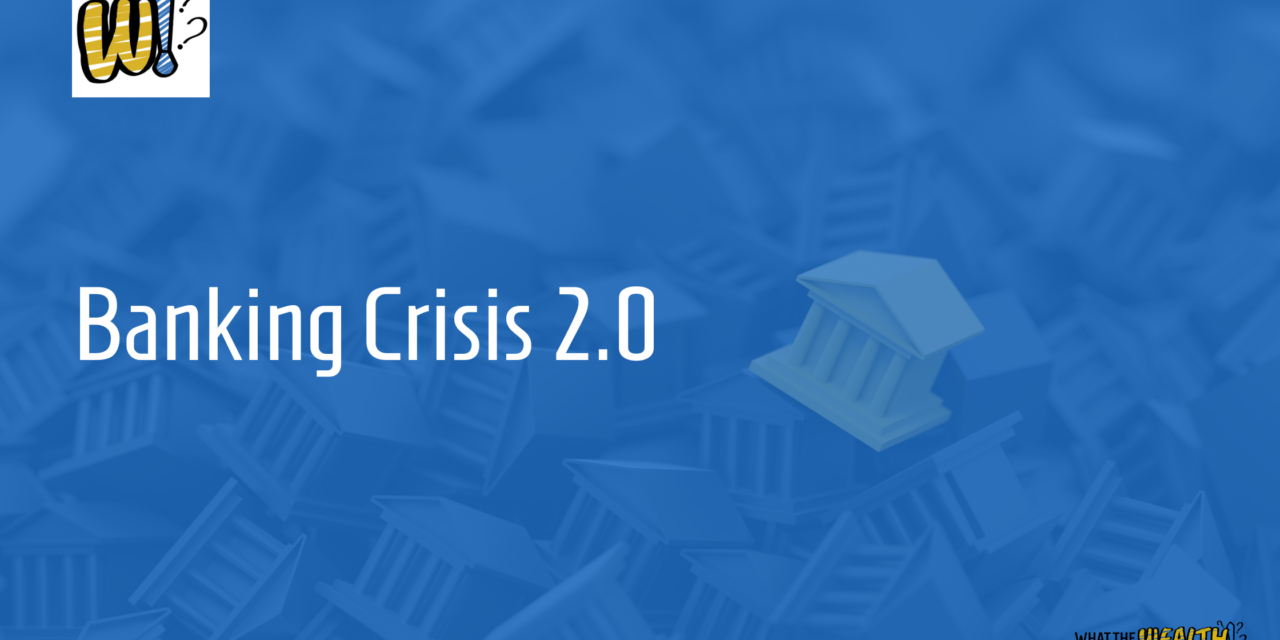What the Wealth Episode 78: Banking Crisis 2.0
The recent collapse of Silicon Valley Bank has made for a stressful couple of weeks for the banking industry, the economy as a whole, and investors and brought back the specter of the Great Financial Crisis of 2008. Will we see a repeat, or was SVB an isolated incident? That’s what we’ll discuss in episode 78 of What the Wealth.
2008 All Over Again?
As word spread that Silicon Valley Bank (SVB) was failing, people started to worry that we were in for a repeat of the 2008 Great Financial Crisis. That seems very unlikely.
Banks today are not seeing a lot of defaulted loans, and defaulted loans are what helped propel the 2008 meltdown. Loans are stronger, companies are stronger, and banks are stronger with better capital ratios.
Of course, that could change as we face a possible recession, layoffs, business failures, and higher interest rates. But banks have accounted for those possibilities and are much more conservative in their practices than they were in the past.
Silicon Valley Bank: The Autopsy
SVB was headquartered in Santa Clara, California, with branches in California and Massachusetts. Located in Silicon Valley, the bank provided services specifically for the tech industry. It was the bank for nearly half of all venture capital-backed tech startups and became the largest bank by deposits in Silicon Valley.
Prior to Covid, SVB had about $60 billion in deposits. But during Covid, tech companies saw an influx of money which meant an influx of deposits for SVB. The bank’s deposits more than tripled to $200 billion in a short period of time.
But SVB wasn’t a normal bank. It didn’t generate a lot of new loans, which accounted for just 10%-12% of its business. That’s because so many of its customers, tech startups, were funded via venture capitalists. So the bank didn’t have to produce a lot of loans to generate income as most banks do.
Instead, SVB was buying long-dated Treasuries, dated ten years or more. At the time, these Treasuries were paying between 0.05%-1.5%, so they were a way to invest some of those deposits and get a return to make a profit and pay the bank’s expenses.
Fast forward to recently. The Fed has been aggressively hiking interest rates in an attempt to cool inflation, and these hikes have put pressure on tech companies, and they were spending more than they had been.
Things continued to get tighter, business was slowing down, and the companies weren’t generating as much cash flow, so they had to begin spending their reserves. This was drawing down the deposits at SVB, so the bank needed to raise some cash. It began selling off some of its Treasuries. But because rates were up, the market value of the Treasuries was down, and the bank took about a $1.8 billion loss.
SVB put out a call that it needed to raise capital, but no one bit, and the call ended up causing a scare throughout the VC community and eventually a scare through Wall and Main Streets.
It caused a run on the bank, and at one point, $42 billion was in the process of being redeemed. Not all of it was, but the run put pressure on other banks.
The Federal Reserve’s Response
On Friday, March 10th, the Fed stepped in and shut the bank down. The bank was made insolvent, and no buyers were found. SVB was not an attractive proposition because it didn’t make its money on traditional loans the way most banks do.
The FDIC insures bank accounts up to $250,000, but most of SVB’s customers were businesses, not individuals, so most accounts held much more than the FDIC guarantee limit. On Sunday, March 12th, the Fed announced that it would fully guarantee all deposits, and the immediate crisis was over.
This move eased a lot of fears, and some pressure on the banking world, but the worry was still there. Would the contagion spread to other banks? Some banks were shut down, including Silvergate, a crypto bank, which shut down before SVB and Signature Bank in New York. Credit Suisse was under pressure, but that situation had been going on for some time.
What the Banking Crisis Means for You
The run on SVB was shouted from the rooftops via social media by some people who just happen to be venture capitalists and investors and who may have some incentive to rile up panic. Is your money safe? Be careful who you listen to when there is a crisis happening. What are people saying, and why might they be saying it?
SVB made some mistakes with how the bank positioned its investments, and there could be other banks facing the same risk for the same reason. Do I think the crisis will be widespread like in 2008? There could be some bleed over into regional banks, but I don’t believe a broader crisis is likely.
That could change fast, though, and without warning. Depositors are spooked, and it might not take much for them to run another bank and cause it to go insolvent. Continued rate hikes, a recession, growing unemployment, if these things happen, we could see more failures than are normal.
And banks do fail, not often, but they do. In the past 22 years, 563 American banks have failed. But less than 1% of FDIC-insured banks have failed each year over the past decade.
But a handful of banks failing isn’t going to plunge us into a significant, systemic crisis like in 2008. And SVB was allowed to fail. The government could have bailed it out, as it almost certainly would if a heavy hitter like Chase or Bank of America were to go down. Those banks are literally too big to fail. The government only stepped in to bail out depositors.
Takeaways
The main takeaway from all of this is that these black swan events can happen and are virtually impossible to predict. Covid was a black swan event. A black swan is “an unpredictable event beyond what is normally expected of a situation and has potentially severe consequences.”
These events can happen at a moment’s notice and change the investing landscape. When creating an investment strategy, it’s important to be diversified and to understand the market, and respect that things can happen and fast. And don’t abandon that strategy when history shows that we tend to weather black swan events pretty well when we zoom out over time.
We’ll weather this too. There will be some short-term consequences, but long-term, it will barely be remembered. I remind myself that I don’t own stocks on paper, I own companies that create great goods and services, and as long as we remain a consumption-based economy, that benefits all long-term investors.
The other takeaway is cash. What are you doing for cash planning? Do you have more than $250,000 in a bank account? You might consider some options; put some of the money in a different bank, look at low-risk investment options.
Most individuals don’t keep that kind of cash in a bank account, but business owners do. The government bailed out SVB’s depositors, but maybe the next group won’t be so lucky.
Stay The Course
I challenge you to stay on course and to be confident in your financial plan. We’ll weather the storm, don’t bail out. A properly diversified portfolio was built to handle these kinds of crises and come out the other side.
Check out my new YouTube channels. The videos are short, walk and talks, where I take a stroll and talk about whatever’s on my mind. And I have a Paradigm Wealth Partners channel too.
Listen to the Full Episode:
What You’ll Learn In Today’s Episode:
- The key differences between the 2008 crisis and now.
- How things could be different this time around and what to keep an eye out for.
- What Silicon Valley Bank is and what happened to them.
- The immediate aftermath of the banking crisis and the “solutions” involved.
- How to look at the situation objectively from start to finish.
- What was allowed to fail and what was covered.
- How to guard against “black swan” events like this.
Ideas Worth Sharing:
- “Today, the banks are not having a lot of defaults on loans. Loans are stronger, companies are stronger, the banks are stronger – they have better capital ratios and are, overall, in a much stronger position than they were back in 2008.” – Jonathan Bednar
- “I don’t think we’ll see this bleed over into regional banks. However, that could change and it could change very very fast.” – Jonathan Bednar
- “When you create your investment plan, it’s important to be diversified and to have the understanding and respect of the market to know things can happen to the market very quickly.” – Jonathan Bednar
Resources In Today’s Episode:
- What The Wealth?! by Jonathan Bednar
Enjoy the show? Use the Links Below to Subscribe:





